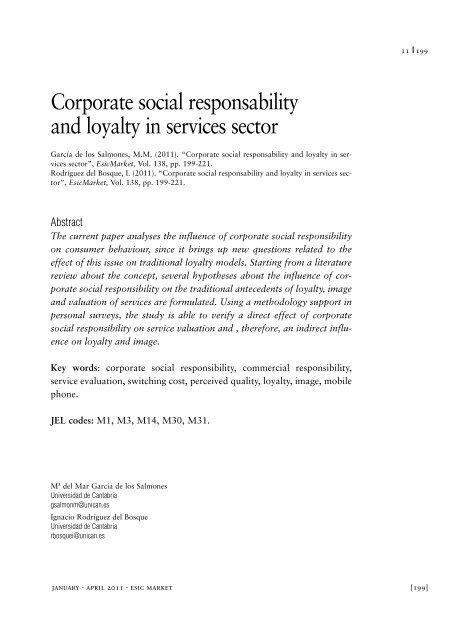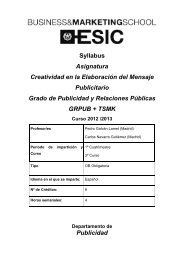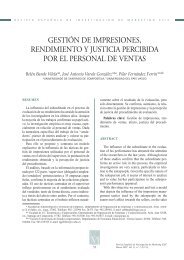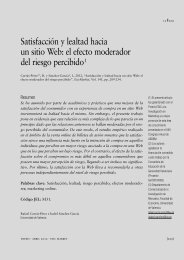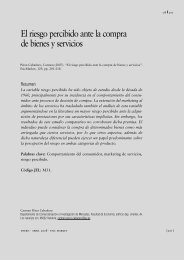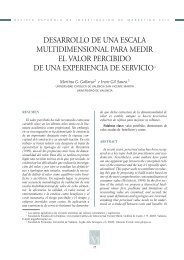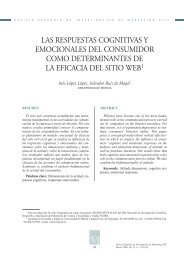Corporate social responsability and loyalty in services sector - Esic
Corporate social responsability and loyalty in services sector - Esic
Corporate social responsability and loyalty in services sector - Esic
You also want an ePaper? Increase the reach of your titles
YUMPU automatically turns print PDFs into web optimized ePapers that Google loves.
<strong>Corporate</strong> <strong>social</strong> <strong>responsability</strong><br />
<strong>and</strong> <strong>loyalty</strong> <strong>in</strong> <strong>services</strong> <strong>sector</strong><br />
García de los Salmones, M.M. (2011). “<strong>Corporate</strong> <strong>social</strong> <strong>responsability</strong> <strong>and</strong> <strong>loyalty</strong> <strong>in</strong> <strong>services</strong><br />
<strong>sector</strong>”, <strong>Esic</strong>Market, Vol. 138, pp. 199-221.<br />
Rodríguez del Bosque, I. (2011). “<strong>Corporate</strong> <strong>social</strong> <strong>responsability</strong> <strong>and</strong> <strong>loyalty</strong> <strong>in</strong> <strong>services</strong> <strong>sector</strong>”,<br />
<strong>Esic</strong>Market, Vol. 138, pp. 199-221.<br />
Abstract<br />
The current paper analyses the <strong>in</strong>fluence of corporate <strong>social</strong> responsibility<br />
on consumer behaviour, s<strong>in</strong>ce it br<strong>in</strong>gs up new questions related to the<br />
effect of this issue on traditional <strong>loyalty</strong> models. Start<strong>in</strong>g from a literature<br />
review about the concept, several hypotheses about the <strong>in</strong>fluence of corporate<br />
<strong>social</strong> responsibility on the traditional antecedents of <strong>loyalty</strong>, image<br />
<strong>and</strong> valuation of <strong>services</strong> are formulated. Us<strong>in</strong>g a methodology support <strong>in</strong><br />
personal surveys, the study is able to verify a direct effect of corporate<br />
<strong>social</strong> responsibility on service valuation <strong>and</strong> , therefore, an <strong>in</strong>direct <strong>in</strong>fluence<br />
on <strong>loyalty</strong> <strong>and</strong> image.<br />
Key words: corporate <strong>social</strong> responsibility, commercial responsibility,<br />
service evaluation, switch<strong>in</strong>g cost, perceived quality, <strong>loyalty</strong>, image, mobile<br />
phone.<br />
JEL codes: M1, M3, M14, M30, M31.<br />
Mª del Mar García de los Salmones<br />
Universidad de Cantabria<br />
gsalmonm@unican.es<br />
Ignacio Rodríguez del Bosque<br />
Universidad de Cantabria<br />
rbosquei@unican.es<br />
january · april 2011 · esic market<br />
11<br />
199<br />
[199]
200 11<br />
[200]<br />
corporate <strong>social</strong> <strong>responsability</strong> <strong>and</strong> <strong>loyalty</strong> <strong>in</strong> <strong>services</strong> <strong>sector</strong><br />
1. Introduction<br />
In the 60s the idea that companies had responsibilities towards their environment<br />
beyond their legal <strong>and</strong> economic obligations was advocated; the<br />
concept of <strong>social</strong> responsibility arose <strong>and</strong> several currents of study tried to<br />
give it some content <strong>and</strong> to analyse its real <strong>in</strong>fluence. We f<strong>in</strong>d ourselves <strong>in</strong><br />
a new stage, where companies are aware of the need to act responsibly.<br />
Consequently, the analysis of widely studied market<strong>in</strong>g variables have to<br />
be reset.<br />
The objective of this research is to study the concept of corporate <strong>social</strong><br />
responsibility <strong>and</strong> to verify if behaviour guided by legality, honesty <strong>and</strong><br />
<strong>social</strong> orientation should be <strong>in</strong>cluded as an additional variable <strong>in</strong> the study<br />
of the user’s <strong>loyalty</strong> to a service. Concretely, its <strong>in</strong>fluence on the perception<br />
of the service quality <strong>and</strong> global image of the company is analyzed; variables<br />
that, together with switch<strong>in</strong>g cost, have been traditionally <strong>in</strong>cluded<br />
<strong>in</strong> <strong>loyalty</strong> models.<br />
Interest <strong>in</strong> carry<strong>in</strong>g out this work comes from various aspects. On the<br />
one h<strong>and</strong>, good <strong>social</strong> behaviour has proven to have an <strong>in</strong>fluence on<br />
image (Brown <strong>and</strong> Dac<strong>in</strong>, 1997; Sen <strong>and</strong> Bhattacharya, 2001), although<br />
these studies are only centred on corporate philanthropy. The consideration<br />
of <strong>social</strong> responsibility as a multi-dimensional concept thus limits<br />
those papers analyz<strong>in</strong>g <strong>social</strong> matters only (Seifert, Morris <strong>and</strong> Bartkus,<br />
2003). On the other h<strong>and</strong>, the lack of research on the effect of <strong>social</strong><br />
responsibility <strong>in</strong> the consumers’ segment is still evident. For <strong>in</strong>stance, <strong>in</strong><br />
the service <strong>sector</strong> there is a greater implication with consumers, therefore<br />
the perception of responsible behaviour is liable to acquire great<br />
importance <strong>and</strong> have direct consequences on the evaluation of service<br />
<strong>and</strong> perceived quality (Sureshch<strong>and</strong>ar, Rajendran <strong>and</strong> Kamalanabhan,<br />
2001).<br />
F<strong>in</strong>ally, many conclusions have been extracted us<strong>in</strong>g experimental<br />
methodologies (Sen <strong>and</strong> Bhattacharya, 2001; Berens, Van Riel <strong>and</strong> Van<br />
Bruggen, 2005), although <strong>in</strong> a real context the results may vary. For this<br />
reason, <strong>in</strong> this work the methodology of surveys is used to collect direct<br />
measurements of the knowledge <strong>and</strong> op<strong>in</strong>ion of consumers on the <strong>social</strong><br />
responsibility of companies.<br />
january · april 2011 · esic market
january · april 2011 · esic market<br />
corporate <strong>social</strong> <strong>responsability</strong> <strong>and</strong> <strong>loyalty</strong> <strong>in</strong> <strong>services</strong> <strong>sector</strong><br />
2. Concept <strong>and</strong> content of <strong>social</strong>ly responsible behaviour<br />
The creation of value with<strong>in</strong> a company is related with the ma<strong>in</strong>tenance of<br />
responsible behaviour with all stakeholders (Clarkson, 1995); this fact<br />
implies develop<strong>in</strong>g honest bus<strong>in</strong>ess practices, offer<strong>in</strong>g safe <strong>and</strong> quality<br />
products, tak<strong>in</strong>g good care of employees, respect<strong>in</strong>g the environment <strong>and</strong><br />
gett<strong>in</strong>g <strong>in</strong>volved <strong>in</strong> <strong>social</strong> causes (Esroch <strong>and</strong> Leichty, 1998). All this without<br />
forgett<strong>in</strong>g that companies have economic obligations, related with<br />
be<strong>in</strong>g productive, obta<strong>in</strong><strong>in</strong>g profit <strong>and</strong> improv<strong>in</strong>g their efficiency (Carroll,<br />
1991; Maignan, et al., 1999). These ideas are related to the philosophy of<br />
<strong>social</strong> responsibility, which leaves aside the idea that organizations should<br />
only be shareholder-oriented, to <strong>in</strong>corporate other matters <strong>in</strong> corporate<br />
strategy plann<strong>in</strong>g. Accord<strong>in</strong>g to Carroll (1979), companies have economic,<br />
legal, ethical <strong>and</strong> philanthropic responsibilities with respect to all their<br />
stakeholders, <strong>and</strong> these four dimensions give shape to the structure of<br />
<strong>social</strong> responsibility.<br />
This model has become a reference to expla<strong>in</strong> responsible behaviour<br />
(Lew<strong>in</strong> et al., 1995; Maignan et al., 1999); however, <strong>in</strong> some studies,<br />
doubts are <strong>in</strong>troduced <strong>in</strong> the <strong>in</strong>clusion of economic matters (Maignan <strong>and</strong><br />
Ferrell, 2001). Actually, Aupperle et al. (1985) observe that this dimension<br />
is <strong>in</strong>versely correlated with the rema<strong>in</strong><strong>in</strong>g associations; this result leads<br />
them to consider the categories “concern for society” <strong>and</strong> “concern for<br />
economic outcome”. In the same way, García de los Salmones et al. (2005)<br />
verify that consumers do not <strong>in</strong>clude the economic dimension <strong>in</strong> the global<br />
construct of corporate <strong>social</strong> responsibility, <strong>and</strong> Bigné et al. (2006)<br />
notice that economic issues are weakly associated with corporate <strong>social</strong><br />
responsibility practices.<br />
This matter is resolved with the contribution of Graafl<strong>and</strong> et al. (2004).<br />
Accord<strong>in</strong>g to these authors, economic dimension is related with product<br />
merch<strong>and</strong>is<strong>in</strong>g. Equally, follow<strong>in</strong>g De la Cuesta <strong>and</strong> Valor (2003), economic<br />
responsibility, from the consumer perspective, is related to tra<strong>in</strong> <strong>and</strong><br />
motivate the personnel who take part <strong>in</strong> the sales process, <strong>and</strong> to <strong>in</strong>novate<br />
<strong>and</strong> improve rhe production process <strong>in</strong> order to offer quality products.<br />
This fact leads us to consider a “commercial responsibility” concept, lean<strong>in</strong>g<br />
on the concepts of quality <strong>and</strong> perceived value, variables that are tra-<br />
11<br />
201<br />
[201]
202 11<br />
[202]<br />
corporate <strong>social</strong> <strong>responsability</strong> <strong>and</strong> <strong>loyalty</strong> <strong>in</strong> <strong>services</strong> <strong>sector</strong><br />
ditionally studied <strong>in</strong> market<strong>in</strong>g literature (Bloemer et al., 1999; Hellier et<br />
al., 2003).<br />
Concern<strong>in</strong>g the <strong>in</strong>clusion of <strong>social</strong> matters, there are not many doubts<br />
on this matter. In fact, corporate <strong>social</strong> responsibility was <strong>in</strong>tended on<br />
some occasions to be a one-dimensional variable, centred on the company’s<br />
orientation towards society <strong>and</strong> environment (Brown <strong>and</strong> Dac<strong>in</strong>,<br />
1997; H<strong>and</strong>elmann <strong>and</strong> Arnold, 1999). However, consider<strong>in</strong>g that responsible<br />
behaviour <strong>in</strong>cludes all moral obligations that maximize the company’s<br />
positive impact on the <strong>social</strong> environment <strong>and</strong> m<strong>in</strong>imize its negative<br />
one (Pride <strong>and</strong> Ferrell, 1997), it is more correct to widen the concept <strong>and</strong><br />
regard it as multidimensional (Maignan, 2001; Graafl<strong>and</strong> et al., 2004).<br />
3. Socially responsible behaviour <strong>in</strong> <strong>loyalty</strong> models:<br />
literary review <strong>and</strong> foundation of research hypotheses<br />
The purchase of some products can be risky for consumers, a fact that<br />
should encourage market<strong>in</strong>g managers to analyze the perceptions of their<br />
products <strong>and</strong> br<strong>and</strong>s <strong>and</strong> the strategies used on the part of clients when it<br />
comes to buy<strong>in</strong>g (Pérez, 2008). The same analysis must be done <strong>in</strong> order<br />
to identify the key attributes to create customer <strong>loyalty</strong>. In this sense, the<br />
first one is to def<strong>in</strong>e the true <strong>loyalty</strong>, differentiat<strong>in</strong>g on this matter two<br />
approaches: behavioural <strong>and</strong> attitud<strong>in</strong>al. The behavioural perspective considers<br />
consumers to be loyal when they rebuy the product or use a service<br />
cont<strong>in</strong>ually (Jones et al., 2000). However, this approach has been criticized<br />
because it does not take affective issues <strong>in</strong>to account. The second perspective<br />
overcomes this limitation def<strong>in</strong><strong>in</strong>g <strong>loyalty</strong> as “the degree to which a<br />
customer exhibits repeat purchas<strong>in</strong>g behaviour from a service provider,<br />
possesses a positive attitud<strong>in</strong>al disposition toward the provider, <strong>and</strong> considers<br />
us<strong>in</strong>g only this provider when a need for this service arises’’ (Gremler<br />
y Brown, 1996). Therefore, the role of attitude <strong>in</strong> customer <strong>loyalty</strong> is<br />
vital, s<strong>in</strong>ce a previous positive attitude is required to consider repetitive<br />
behaviour as true <strong>loyalty</strong> (García et al., 2006).<br />
Tak<strong>in</strong>g <strong>in</strong>to account this second perspective, it is common to <strong>in</strong>clude<br />
perceived service quality, image <strong>and</strong> switch<strong>in</strong>g costs as <strong>in</strong>dependent variables<br />
<strong>in</strong> the <strong>loyalty</strong> models. On the one h<strong>and</strong>, <strong>and</strong> consider<strong>in</strong>g that true<br />
january · april 2011 · esic market
january · april 2011 · esic market<br />
corporate <strong>social</strong> <strong>responsability</strong> <strong>and</strong> <strong>loyalty</strong> <strong>in</strong> <strong>services</strong> <strong>sector</strong><br />
<strong>loyalty</strong> is based on satisfaction (Day, 1969), the global evaluation of the<br />
service offered undoubtedly holds prevalence, <strong>and</strong> there is a consensus <strong>in</strong><br />
affirm<strong>in</strong>g a direct <strong>and</strong> positive relationship between both concepts (Zeithaml<br />
et al., 1996; Joneset al., 2000; Ayd<strong>in</strong> et al., 2005). We l<strong>in</strong>k this evaluation<br />
with the perception of commercial responsibility, which <strong>in</strong>cludes<br />
aspects related to technical quality, <strong>in</strong>terpersonal relationships (Parasuraman<br />
et al., 1988; Grönroos, 1994) <strong>and</strong> perceived value (Parasuraman et<br />
al., 1994; Zeithaml, 1988).<br />
Br<strong>and</strong> image is another variable with positive <strong>in</strong>fluence on <strong>loyalty</strong><br />
(Selnes, 1993; Nguyen y LeBlanc, 2001; Flavián y Gu<strong>in</strong>aliu, 2007). Image<br />
is an overall evaluation of the company, a subjective <strong>and</strong> <strong>in</strong>tangible judgment<br />
relat<strong>in</strong>g to emotional connections between consumer <strong>and</strong> the br<strong>and</strong><br />
(Rust et al., 2000). It <strong>in</strong>cludes feel<strong>in</strong>gs <strong>and</strong> associations (Barich y Kotler,<br />
1991) <strong>and</strong> it is created as a result of a process generated by the perception<br />
of a company’s concrete attributes <strong>and</strong> global impressions (Zimmer <strong>and</strong><br />
Golden, 1998).<br />
F<strong>in</strong>ally, together with commercial behaviour <strong>and</strong> perceived image,<br />
switch<strong>in</strong>g costs are liable to play an important role (De Ruyter et al., 1998;<br />
Ayd<strong>in</strong> et al., 2005). They encompass any factor that makes it difficult for<br />
consumers to change their suppliers, for example the mental effort<br />
required to search for <strong>in</strong>formation from other alternatives (De Ruyter et<br />
al., 1998). When these barriers appear, consumers become less sensitive to<br />
levels of satisfaction when they show their <strong>loyalty</strong> towards a br<strong>and</strong><br />
(Hauser et al., 1994). We can therefore say that:<br />
Hypothesis 1: The perception of the commercial responsibility of a company<br />
has a direct <strong>and</strong> positive <strong>in</strong>fluence on <strong>loyalty</strong> towards the service.<br />
Hypothesis 2: The image of a company has a direct <strong>and</strong> positive <strong>in</strong>fluence<br />
on <strong>loyalty</strong> towards the service.<br />
Hypothesis 3: The existence of switch<strong>in</strong>g costs has a direct <strong>and</strong> positive<br />
<strong>in</strong>fluence on <strong>loyalty</strong> towards the service.<br />
The antecedents of image become factors <strong>in</strong>directly <strong>in</strong>fluenc<strong>in</strong>g <strong>loyalty</strong>.<br />
Firstly, experience with a company itself <strong>in</strong>fluences the process of image<br />
11<br />
203<br />
[203]
204 11<br />
[204]<br />
corporate <strong>social</strong> <strong>responsability</strong> <strong>and</strong> <strong>loyalty</strong> <strong>in</strong> <strong>services</strong> <strong>sector</strong><br />
formation, <strong>and</strong> as long as consumers are satisfied with the service offered,<br />
the company image improves (Andreassen <strong>and</strong> L<strong>in</strong>destad, 1998). Actually,<br />
one can expect that commercial responsibility will have a strong impact on<br />
consumers when form<strong>in</strong>g corporate image. Each target audience will be<br />
<strong>in</strong>terested <strong>in</strong> different aspects of the company activity (Fombrun, 1996),<br />
<strong>and</strong> will use different cognitive filters as well as giv<strong>in</strong>g more or less weight<br />
to the different attributes accord<strong>in</strong>g to its relationship <strong>and</strong> <strong>in</strong>terests with<br />
the organization (Caruana, 1997). As far as consumers are concerned, the<br />
quality of the product <strong>and</strong> service received will be key factors <strong>in</strong> image creation,<br />
s<strong>in</strong>ce an important source <strong>in</strong> generat<strong>in</strong>g an impression is the shopp<strong>in</strong>g<br />
experience, <strong>and</strong> global evaluation is a function of that experience<br />
(Ayd<strong>in</strong> et al., 2005). Therefore it is considered that:<br />
Hypothesis 4: The perception of the commercial responsibility of a company<br />
has a direct <strong>and</strong> positive <strong>in</strong>fluence on the corporate image.<br />
On the other h<strong>and</strong>, perceptions of <strong>social</strong> responsibility can also give<br />
substance to the image. L<strong>in</strong>k<strong>in</strong>g a br<strong>and</strong> with ethical <strong>and</strong> <strong>social</strong> matters<br />
enforces its br<strong>and</strong> value (Berry, 2000; Rust et al., 2000), <strong>in</strong> so far as how<br />
values that communicate respect towards the customer <strong>and</strong> enforce confidence<br />
towards a company are transmitted (Maignan et al., 1999). The<br />
relationship that exists between philanthropy <strong>and</strong> corporate reputation<br />
has already been verified <strong>in</strong> previous studies. In some cases, company<br />
rank<strong>in</strong>gs compiled by managers themselves are used, such as lists from<br />
Fortune (Fombrun <strong>and</strong> Shanley, 1990) or Management Today (Brammer<br />
<strong>and</strong> Mill<strong>in</strong>gton, 2005). In others, experimental scenarios <strong>and</strong> methods are<br />
worked on (Brown <strong>and</strong> Dac<strong>in</strong>, 1997; Lafferty <strong>and</strong> Goldsmith, 1999;<br />
Mohr <strong>and</strong> Webb, 2005; Ricks 2005). In a real-life context the results may<br />
vary, s<strong>in</strong>ce communication on <strong>social</strong> responsibility is still at an <strong>in</strong>itial<br />
phase (Bigné et al., 2005) <strong>and</strong> there may be a lack of knowledge by consumers<br />
which may expla<strong>in</strong> that <strong>social</strong> <strong>and</strong> ethical matters are not taken<br />
<strong>in</strong>to consideration when the company is evaluated (Maignan <strong>and</strong> Ferrell,<br />
2004). Nevertheless, with reference to experimental work, it is considered<br />
that:<br />
january · april 2011 · esic market
january · april 2011 · esic market<br />
corporate <strong>social</strong> <strong>responsability</strong> <strong>and</strong> <strong>loyalty</strong> <strong>in</strong> <strong>services</strong> <strong>sector</strong><br />
Hypothesis 5: The perception of corporate <strong>social</strong> responsibility has a direct<br />
<strong>and</strong> positive <strong>in</strong>fluence on the global image of a company.<br />
F<strong>in</strong>ally, the sense of confidence which a <strong>social</strong>ly responsible company<br />
transmits can also <strong>in</strong>fluence the evaluation the consumer makes on the<br />
global quality of the service received, <strong>in</strong> so far as consumers assume that a<br />
company ma<strong>in</strong>ta<strong>in</strong><strong>in</strong>g this behaviour is honest, <strong>and</strong> thus will offer quality<br />
products (McWilliams <strong>and</strong> Siegel, 2001). <strong>Corporate</strong> <strong>social</strong> responsibility<br />
can add value to a product (Mohr <strong>and</strong> Webb, 2005) <strong>and</strong> <strong>in</strong> fact,<br />
Sureshch<strong>and</strong>ar et al. (2001) <strong>and</strong> Sureshch<strong>and</strong>ar et al. (2002) consider that<br />
ethical behaviour can be seen as an extra component <strong>in</strong> service quality.<br />
Furthermore, a good <strong>social</strong> image has a positive effect on product evaluation<br />
(Brown <strong>and</strong> Dac<strong>in</strong>, 1997; Kle<strong>in</strong> <strong>and</strong> Dawar, 2003). It is established<br />
that:<br />
Hypothesis 6: The perception of corporate <strong>social</strong> responsibility has a positive<br />
<strong>and</strong> direct <strong>in</strong>fluence on the perception of commercial responsibility.<br />
Therefore, the hypotheses shape a tri-component model: cognitive,<br />
affective <strong>and</strong> conative (Lutz, 1991; N<strong>and</strong>an, 2005). The cognitive component<br />
refers to the consumer’s knowledge or belief system about the br<strong>and</strong>,<br />
<strong>in</strong> this case the perception of commercial <strong>and</strong> <strong>social</strong> responsibility, formed<br />
by experiences of consumers, personal characteristics <strong>and</strong> <strong>in</strong>formation<br />
received about the company. These perceptions give rise to the affective<br />
component, specifically an image or overall evaluation that <strong>in</strong>cludes emotions<br />
<strong>and</strong> feel<strong>in</strong>gs. The cognitive <strong>and</strong> affective elements, together with<br />
switch<strong>in</strong>g costs, <strong>in</strong>fluence the consumer behaviour with respect to the<br />
br<strong>and</strong> (Figure 1).<br />
11<br />
205<br />
[205]
206 11<br />
Figure 1. Model of <strong>loyalty</strong><br />
[206]<br />
Brown <strong>and</strong> Dac<strong>in</strong> (1997),<br />
Kle<strong>in</strong> <strong>and</strong> Dawar (2003),<br />
Mohr <strong>and</strong> Webb (2005,<br />
Suresch<strong>and</strong>ar et al.<br />
(2002)<br />
<strong>Corporate</strong> Social<br />
Responsibility<br />
Fombrun <strong>and</strong> Shanley<br />
(1990), Brown <strong>and</strong><br />
Dac<strong>in</strong> (1997), Mohr<br />
<strong>and</strong> Webb (2005),<br />
Ricks (2005)<br />
(1) Amena changed its<br />
br<strong>and</strong> name to Orange<br />
<strong>in</strong> October 2006. That<br />
year a new br<strong>and</strong>,<br />
Yoigo, was launched<br />
<strong>in</strong>to the market.<br />
Nowadays, these<br />
companies compete<br />
with other virtual<br />
entities.<br />
(2) M<strong>in</strong>istry of<br />
Industry, Tourism <strong>and</strong><br />
Commerce.<br />
corporate <strong>social</strong> <strong>responsability</strong> <strong>and</strong> <strong>loyalty</strong> <strong>in</strong> <strong>services</strong> <strong>sector</strong><br />
H6 +<br />
H5 +<br />
Commercial<br />
Responsibility<br />
H4 +<br />
Global Image<br />
Jones et al. (2000), Ayd<strong>in</strong><br />
et al. (2005)<br />
Fombrun (1996),<br />
Andreassen <strong>and</strong> L<strong>in</strong>estad<br />
(1998), Ayd<strong>in</strong> et al. (2005)<br />
H2 +<br />
H1 +<br />
Loyalty<br />
Selnes (1993), Andreassen<br />
<strong>and</strong> L<strong>in</strong>estad (1998),<br />
Nguyen <strong>and</strong> LeBlanc (2001)<br />
De Ruyter et al.<br />
(1998), Colgate y Lang (2001)<br />
Aydien et al. (2005)<br />
Switch<strong>in</strong>g costs<br />
4. Research methodology<br />
Research activity is applied on the mobile phone market. Three companies<br />
operate <strong>in</strong> this market (Telefónica Móviles, Vodafone <strong>and</strong> Orange 1 ), which<br />
ma<strong>in</strong>ta<strong>in</strong> high notoriety rates (over 97% penetration <strong>in</strong> December 2005 2 )<br />
<strong>and</strong> an active behaviour <strong>in</strong> <strong>social</strong> responsibility matters.<br />
Data is derived from market<strong>in</strong>g research carried out <strong>in</strong> Cantabria <strong>in</strong><br />
April 2004. Personal surveys were carried out, obta<strong>in</strong><strong>in</strong>g a total of 689<br />
valid surveys, with a ±3.7% sample error, lead<strong>in</strong>g to a 95% confidence level<br />
<strong>and</strong> to the most unfavourable case (p=q=0.5). Data is processed with<br />
statistic software applications SPSS 14.0 <strong>and</strong> EQS 5.7b. The sampl<strong>in</strong>g procedure<br />
used is non-probabilistic. Specifically, a quota stratification is<br />
employed <strong>in</strong> accordance with two socio-demographic criteria: <strong>in</strong>dividuals’<br />
age <strong>and</strong> gender.<br />
To measure commercial responsibility, user satisfaction with different<br />
service attributes is considered. Technical <strong>and</strong> functional quality is analyzed,<br />
as well as the perceived value, referr<strong>in</strong>g to the studies of Lee et al.<br />
(2001) <strong>and</strong> Olsen <strong>and</strong> Johnson (2003). As for the <strong>social</strong> responsibility<br />
H3 +<br />
january · april 2011 · esic market
january · april 2011 · esic market<br />
corporate <strong>social</strong> <strong>responsability</strong> <strong>and</strong> <strong>loyalty</strong> <strong>in</strong> <strong>services</strong> <strong>sector</strong><br />
scale, we <strong>in</strong>itially follow guidel<strong>in</strong>es from Carroll (1979, 1991) <strong>and</strong> we<br />
focus on ethical-legal <strong>and</strong> <strong>social</strong> aspects, i.e., on the “concern with the<br />
company” categories def<strong>in</strong>ed by Aupperle et al. (1985). We use the works<br />
of Brown <strong>and</strong> Dac<strong>in</strong> (1997) <strong>and</strong> Maignan (2001) to back up its design.<br />
In order to assure content validity, a previous quality 3 study was performed,<br />
<strong>and</strong> various pre-tests were carried out before clos<strong>in</strong>g the questionnaire.<br />
The global image is measured with items <strong>in</strong> the scale from Rust et al.<br />
(2000) <strong>and</strong> for switch<strong>in</strong>g costs the items used <strong>in</strong> the work of Jones et al.<br />
(2000) are considered. F<strong>in</strong>ally, <strong>loyalty</strong> is measured with items derived<br />
from the commitment scale from Delgado <strong>and</strong> Munuera (2001) <strong>and</strong> from<br />
the scale from Zeithaml et al. (1996). All scales are detailed <strong>in</strong> the Appendix.<br />
5. Results of the research<br />
In the first place, reliability <strong>and</strong> validity of all constructs of the casual<br />
model are verified by means of confirmatory analysis 4 . The established<br />
model is correct (see Table 1), s<strong>in</strong>ce all second order latent variables have<br />
<strong>in</strong>ternal consistency, as shown by the value of Cronbach α coefficient <strong>and</strong><br />
the composed reliability coefficient. Moreover, the st<strong>and</strong>ardized coefficients<br />
are significant <strong>and</strong> have a value greater than 0.5, thus guarantee<strong>in</strong>g<br />
the convergent validity of all dimensions (Steemkamp <strong>and</strong> Van Trijp,<br />
1991).<br />
11<br />
207<br />
(3) Several focus<br />
groups were organized,<br />
with users of various<br />
ages, gender <strong>and</strong><br />
mobile phone<br />
companies.<br />
(4) In the first place, a<br />
second order<br />
confirmatory analysis<br />
with the constructs<br />
commercial<br />
responsibility <strong>and</strong><br />
corporate <strong>social</strong><br />
responsibility was<br />
carried out. The results<br />
were optimal <strong>in</strong> both<br />
cases <strong>and</strong> it was<br />
possible to confirm the<br />
discrim<strong>in</strong>ant <strong>and</strong><br />
convergent validity <strong>and</strong><br />
the reliability.<br />
[207]
208 11<br />
Table 1. Confirmatory Analysis<br />
[208]<br />
Latent variable<br />
Commercial<br />
Responsibility (CR)<br />
<strong>Corporate</strong> Social<br />
Responsibility (CSR)<br />
Image (IM)<br />
Switch<strong>in</strong>g Costs (SC)<br />
Loyalty (LOYAL)<br />
(5) Values are<br />
averaged to facilitate<br />
the analysis.<br />
corporate <strong>social</strong> <strong>responsability</strong> <strong>and</strong> <strong>loyalty</strong> <strong>in</strong> <strong>services</strong> <strong>sector</strong><br />
Measured<br />
variable<br />
St<strong>and</strong>ard<br />
lambda<br />
R 2<br />
TQ 0.63 0.40<br />
FQ 0.76 0.58<br />
PV 0.74 0.827<br />
ELR 0.90 0.82<br />
FR 0.81 0.67<br />
FEEL 0.67 0.45<br />
OPIN 0.85 0.73<br />
TROUB 0.83 0.69<br />
EFFO 0.94 0.88<br />
COST 0.83 0.70<br />
LOY 0.69 0.48<br />
BEST 0.81 0.66<br />
RECOM 0.89 0.80<br />
CHOO 0.86 0.75<br />
CONT 0.75 0.57<br />
Cronbach’s<br />
α<br />
Composite<br />
reliability<br />
0.83 0.75<br />
0.82 0.85<br />
0.72 0.67<br />
0.90 0.90<br />
0.90 0.94<br />
Goodness of fit<br />
<strong>in</strong>dices<br />
S-Bχ 2 = 656.32<br />
(p=0.0000)<br />
BBNFI = 0.91<br />
BNNFI = 0.93<br />
CFI = 0.94<br />
RMSEA = 0.04<br />
The discrim<strong>in</strong>ant validity of the model is evaluated from confidence<br />
<strong>in</strong>tervals for pairs or latent concepts (Table 2). It was verified that none of<br />
the calculated confidence <strong>in</strong>tervals for the two-on-two variable verifications<br />
<strong>in</strong>cludes unity (Anderson <strong>and</strong> Gerb<strong>in</strong>g, 1988) 5 .<br />
january · april 2011 · esic market
january · april 2011 · esic market<br />
corporate <strong>social</strong> <strong>responsability</strong> <strong>and</strong> <strong>loyalty</strong> <strong>in</strong> <strong>services</strong> <strong>sector</strong><br />
Table 2. Correlations <strong>and</strong> discrim<strong>in</strong>at validity<br />
CR –<br />
CSR<br />
IM<br />
SC<br />
LOY<br />
Correlations <strong>and</strong> confidence <strong>in</strong>tervals for the correlations<br />
CR CSR IM SC LOY<br />
0.69<br />
(0.294-0.506) –<br />
0.85 0.61<br />
(0.343-0.563) (0.339-0.555) –<br />
0.19 0.19 0.25<br />
(0.091 – 0.327) (0.123 – 0.439) (0.196 – 0.480) –<br />
0.76 0.41 0.74 0.31<br />
(0.46 – 0.89) (0.353 – 0.625) (0.649 – 0.965) (0.464 – 0.892) –<br />
The structural model that allows us to contrast the established<br />
hypotheses is presented below (Figure 2). The <strong>in</strong>dexes of goodness of<br />
fit are acceptable, s<strong>in</strong>ce the statistics values go beyond the optimal values<br />
6 . In the first place it is proven how the perception of commercial<br />
responsibility, measured through technical <strong>and</strong> functional quality evaluation<br />
<strong>and</strong> perceived price, <strong>in</strong>fluences directly, positively <strong>and</strong> significantly<br />
on the user’s <strong>loyalty</strong>. Kugyte <strong>and</strong> Sliburyte (2007) verify that <strong>in</strong><br />
the mobile phone <strong>sector</strong>, the issues related to price, personal treatment,<br />
range <strong>and</strong> reliability are extremely important selection criteria. And<br />
from the results of the model, we can gather that they are also key variables<br />
to expla<strong>in</strong> <strong>loyalty</strong>. In the same manner, the impressions one has<br />
of a company <strong>in</strong>fluence the <strong>loyalty</strong> shown towards it, as well as switch<strong>in</strong>g<br />
costs do. It is observed that people perceiv<strong>in</strong>g costs <strong>in</strong> time, effort<br />
<strong>and</strong> money to change br<strong>and</strong> are more loyal than <strong>in</strong>dividuals with an<br />
opposite perception. These costs condition the user’s behaviour <strong>and</strong><br />
impulse the consumer to a higher preference <strong>and</strong> commitment towards<br />
the company provid<strong>in</strong>g the service. Therefore, hypotheses 1 to 3 cannot<br />
be refuted.<br />
11<br />
(6) BBNFI = 0.90<br />
BBNNFI=0.94<br />
CFI=0.94<br />
RMSEA=0.05.<br />
209<br />
[209]
210 11<br />
Figure 2. Model of <strong>loyalty</strong><br />
[210]<br />
Ethical-Legal Social<br />
0.91<br />
0.81<br />
corporate <strong>social</strong> <strong>responsability</strong> <strong>and</strong> <strong>loyalty</strong> <strong>in</strong> <strong>services</strong> <strong>sector</strong><br />
Technique Q.<br />
0.81<br />
0.64<br />
Functional Q. Perceived Q.<br />
0.77<br />
Commercial<br />
Responsibility<br />
<strong>Corporate</strong> Social<br />
Responsibility Loyalty<br />
0.65<br />
Global Image<br />
0.37<br />
0.74<br />
Switch<strong>in</strong>g<br />
costs<br />
Social <strong>and</strong> commercial responsibilities are regarded as direct determ<strong>in</strong>ants<br />
of the overall evaluation of the company, <strong>and</strong> therefore, as hav<strong>in</strong>g a<br />
direct <strong>in</strong>fluence on <strong>loyalty</strong>. With respect to this, it is proven that commercial<br />
responsibility is the ma<strong>in</strong> determ<strong>in</strong>ant of image (hypothesis 4 is not<br />
refuted), while <strong>social</strong>ly responsible behaviour has no significant effect.<br />
Although <strong>in</strong> experimental studies the relationship did appear to be significant,<br />
it seems that when tak<strong>in</strong>g direct knowledge <strong>and</strong> evaluation measures<br />
the output varies. This result leads us to reject hypothesis 5. Thus, users let<br />
themselves be guided by their direct experiences with the service when<br />
called upon to evaluate a company, while <strong>social</strong> responsibility plays a secondary<br />
role. Perhaps this is due, as Mohr <strong>and</strong> Webb (2005) prove, to<br />
image be<strong>in</strong>g more affected by receiv<strong>in</strong>g <strong>in</strong>formation about negative practices<br />
than about positive ones, i.e., consumers react very negatively to<br />
<strong>in</strong>formation over irresponsible practice, while they are less sensitive to positive<br />
messages (Sen <strong>and</strong> Battacharya, 2001).<br />
0.40<br />
0.16<br />
Hypothesis supported<br />
Hypothesis not supported<br />
january · april 2011 · esic market
january · april 2011 · esic market<br />
corporate <strong>social</strong> <strong>responsability</strong> <strong>and</strong> <strong>loyalty</strong> <strong>in</strong> <strong>services</strong> <strong>sector</strong><br />
However, the fact that <strong>social</strong> responsibility does <strong>in</strong>fluence global service<br />
evaluation grabs our attention. The ethical behaviour of companies<br />
<strong>and</strong> <strong>social</strong> image have effects on the perception of commercial responsibility<br />
of companies, <strong>and</strong> thus hypothesis 6 is not refuted. Therefore, corporate<br />
<strong>social</strong> responsibility does have an <strong>in</strong>fluence on the consumer’s behaviour<br />
<strong>and</strong> must be <strong>in</strong>cluded <strong>in</strong> <strong>loyalty</strong> models.<br />
6. Research conclusions<br />
The present research is based on the <strong>loyalty</strong> model to <strong>in</strong>corporate matters<br />
of corporate <strong>social</strong> responsibility. Specifically, it establishes several<br />
hypotheses on loyal determ<strong>in</strong>ants <strong>and</strong> the effect of responsible behaviour,<br />
answer<strong>in</strong>g by means of market<strong>in</strong>g research with<strong>in</strong> the mobile phone market<br />
<strong>in</strong> Spa<strong>in</strong>.<br />
Furthermore, op<strong>in</strong>ions on commercial responsibility of companies are<br />
collected, evaluat<strong>in</strong>g perceptions about quality <strong>and</strong> perceived value of service<br />
offered <strong>and</strong> the <strong>social</strong>ly responsible behaviour of companies <strong>in</strong> ethiclegal<br />
<strong>and</strong> philanthropic aspects.<br />
It is proven that <strong>loyalty</strong> towards a service is directly <strong>in</strong>fluenced by the<br />
perception of technical quality <strong>and</strong>, above all, functional quality <strong>and</strong> perceived<br />
value. It is also <strong>in</strong>fluenced <strong>in</strong> a direct manner by the image of the<br />
supply<strong>in</strong>g company <strong>and</strong> by the costs of change perceived by users. Therefore,<br />
companies must be concerned about all impressions they create, fundamentally<br />
those related to market<strong>in</strong>g aspects, <strong>and</strong> develop a relational<br />
market<strong>in</strong>g strategy that favours the creation of switch<strong>in</strong>g costs. This is a<br />
key question nowadays as attract<strong>in</strong>g consumers is necessary for survival,<br />
but it is not enough. The important th<strong>in</strong>g is to keep <strong>and</strong> to create consumer<br />
<strong>loyalty</strong>, stress<strong>in</strong>g the long-term relationship. In order to achieve this goal,<br />
it is necessary to change the traditional market<strong>in</strong>g approach based on the<br />
generic market <strong>and</strong> to put <strong>in</strong>to practice a strategy focused on a one-to-one<br />
relationship (García y Rodríguez, 2004). It is important to start off customer<br />
orientation that takes all aspects related to service quality <strong>in</strong>to consideration;<br />
among those aspects we f<strong>in</strong>d corporate <strong>social</strong> responsibility.<br />
The perception of ethical <strong>and</strong> <strong>social</strong>ly responsible behaviour br<strong>in</strong>gs about<br />
favourable associations that convert <strong>in</strong>to a better evaluation of the service.<br />
11<br />
211<br />
[211]
212 11<br />
[212]<br />
corporate <strong>social</strong> <strong>responsability</strong> <strong>and</strong> <strong>loyalty</strong> <strong>in</strong> <strong>services</strong> <strong>sector</strong><br />
Social responsibility <strong>and</strong> commercial responsibility are thus closely related<br />
with each other, the former <strong>in</strong>fluenc<strong>in</strong>g powerfully on the latter. Accord<strong>in</strong>g<br />
to Pérez (2007), it is advisable to spread <strong>in</strong>formation about the service<br />
offered <strong>and</strong> about the company, with arguments that re<strong>in</strong>force the trust of<br />
consumers. In this sense, <strong>and</strong> due to the results of the research, commercial<br />
campaigns should be complemented with the company’s <strong>social</strong> orientation<br />
be<strong>in</strong>g made public knowledge, us<strong>in</strong>g various methods with<strong>in</strong> the<br />
company’s reach to give implicit <strong>and</strong> explicit reference to its ethical <strong>and</strong><br />
<strong>social</strong> orientation. Smart communication about the corporate <strong>social</strong><br />
responsibility would support the credibility <strong>and</strong> honesty of the firm, <strong>and</strong><br />
therefore would re<strong>in</strong>force perceptions about it.<br />
As far as image is concerned, it turns out that op<strong>in</strong>ions about the company<br />
are created ma<strong>in</strong>ly by contacts <strong>and</strong> experiences with the service. On<br />
this occasion, no direct <strong>in</strong>fluence by <strong>social</strong> responsibility was observed.<br />
The fact that we are consider<strong>in</strong>g a heavily utility-based service, of common<br />
<strong>and</strong> daily use, expla<strong>in</strong>s that <strong>in</strong> this case the perception over the way the<br />
company offers its service <strong>and</strong> cares about customers takes a dom<strong>in</strong>ant<br />
role. Nevertheless, we must remember that <strong>social</strong> responsibility <strong>in</strong>fluences<br />
<strong>in</strong>directly via global evaluation of the service, <strong>and</strong> therefore companies<br />
must make sure that their codes of ethics <strong>and</strong> other <strong>social</strong> responsibility<br />
matters are reflected not only <strong>in</strong> their advertis<strong>in</strong>g, but also <strong>in</strong> their daily<br />
behaviour <strong>and</strong> <strong>in</strong> all contact with the customer. <strong>Corporate</strong> <strong>social</strong> responsibility<br />
is an important way of differentiation, <strong>and</strong> it is capable of creat<strong>in</strong>g<br />
affective responses which support <strong>loyalty</strong>.<br />
F<strong>in</strong>ally we should mention limitations <strong>and</strong> future l<strong>in</strong>es of research.<br />
Firstly, further work on the development of the <strong>social</strong> responsibility scale<br />
is proposed, f<strong>in</strong>e-tun<strong>in</strong>g it with new items. From a different angle it would<br />
be <strong>in</strong>terest<strong>in</strong>g to <strong>in</strong>clude moderat<strong>in</strong>g variables, such as the endorsement<br />
customers give to these measurements, knowledge perceived by companies,<br />
or matters of a <strong>social</strong>-demographic k<strong>in</strong>d. Likewise, future research will<br />
develop the <strong>loyalty</strong> model <strong>and</strong> other important issues, such as commitment,<br />
confidence or identification with the company. The results obta<strong>in</strong>ed<br />
must be considered with<strong>in</strong> the framework of the study conducted; for this<br />
reason, <strong>in</strong> order to generalize results, widen<strong>in</strong>g the study to different sec-<br />
january · april 2011 · esic market
january · april 2011 · esic market<br />
corporate <strong>social</strong> <strong>responsability</strong> <strong>and</strong> <strong>loyalty</strong> <strong>in</strong> <strong>services</strong> <strong>sector</strong><br />
tors, most of all to the ones where sensitivity to <strong>social</strong> matters is a priori<br />
more evident.<br />
References<br />
ANDERSON, J. <strong>and</strong> GERBING, D. (1998). “Structural Equation Modell<strong>in</strong>g<br />
<strong>in</strong> Practice: A Review <strong>and</strong> Recommended Two-Step Approach”,<br />
Psychological Bullet<strong>in</strong>, Vol. 103, nº3, pp. 411-423.<br />
ANDREASSEN, T. <strong>and</strong> LINDESTAD, B. (1998). “Customer Loyalty <strong>and</strong><br />
Complex Services”, International Journal of Service Industry Management,<br />
Vol. 9, nº 1, pp. 7-23.<br />
AUPPERLE, K., CARROLL, A. <strong>and</strong> HATFIELD, J. (1985). “An Empirical<br />
Exam<strong>in</strong>ation of the Relationship Between <strong>Corporate</strong> Social Responsibility<br />
<strong>and</strong> Profitability”, Academy of Management Journal, June, Vol.<br />
28, nº 2, pp. 446-463.<br />
AYDIN, S., ÖZER, G. <strong>and</strong> ARASIL, Ö. (2005). “Customer Loyalty <strong>and</strong><br />
the Effect of Switch<strong>in</strong>g Costs as a Moderator Variable: A Case <strong>in</strong> the<br />
Turkish Mobile Phone Market”, Market<strong>in</strong>g Intelligence & Plann<strong>in</strong>g,<br />
January, Vol. 23, 1, pp. 89-103.<br />
BARICH, H. <strong>and</strong> KOTLER, P. (1991). “A Framework for Market<strong>in</strong>g<br />
Image Management”, Sloan Management Review, W<strong>in</strong>ter, pp. 94-109.<br />
BERENS, G., VAN RIEL, C. <strong>and</strong> VAN BRUGGEN, G. (2005). “<strong>Corporate</strong><br />
Associations <strong>and</strong> Consumer Product Responses: The Moderat<strong>in</strong>g Role<br />
of <strong>Corporate</strong> Br<strong>and</strong> Dom<strong>in</strong>ance”, Journal of Market<strong>in</strong>g, Vol. 69, July,<br />
pp. 35-48.<br />
BERRY, L. (2000). “Cultivat<strong>in</strong>g Service Br<strong>and</strong> Equity”, Journal of the<br />
Academy of Market<strong>in</strong>g Science, Vol. 28, nº 1. , pp. 128-137.<br />
BIGNE, E., ANDREU, L., CHUMPITAZ, R. <strong>and</strong> SWAEN, V. (2006). “La<br />
<strong>in</strong>fluencia de la responsabilidad <strong>social</strong> corporativa en el comportamiento<br />
de compra de estudiantes universitarios” “<strong>Corporate</strong> <strong>social</strong><br />
<strong>responsability</strong> <strong>in</strong>fluences on university students buy<strong>in</strong>g behaviour”<br />
ESIC Market nº 125 Septiembre-Diciembre, pp.135 –<br />
BLOEMER, J. <strong>and</strong> DE RUYTER, K. (1998). “On the Relationship<br />
Between Store Image, Store Satisfaction <strong>and</strong> Store Loyalty”, European<br />
Journal of Market<strong>in</strong>g, Vol. 32, nº5/6, pp. 499-513<br />
11<br />
213<br />
[213]
214 11<br />
[214]<br />
corporate <strong>social</strong> <strong>responsability</strong> <strong>and</strong> <strong>loyalty</strong> <strong>in</strong> <strong>services</strong> <strong>sector</strong><br />
BLOEMER, J., DE RUYTER, K. <strong>and</strong> PEETERS, P. (1998). “Investigat<strong>in</strong>g<br />
Drivers of Bank Loyalty: the Complex Relationship Between Image,<br />
Service Quality <strong>and</strong> Satisfaction”, International Journal of Bank Market<strong>in</strong>g,<br />
16/7, pp. 276-286.<br />
BLOEMER, J., DE RUYTER, K. <strong>and</strong> WETZELS, M. (1999). “L<strong>in</strong>k<strong>in</strong>g Perceived<br />
Service Quality <strong>and</strong> Service Loyalty: A Multidimensional Perspective”,<br />
European Journal of Market<strong>in</strong>g, Vol. 33, nº 11/12, pp. 1082-1097.<br />
BLOEMER, J. <strong>and</strong> KASPER, H. (1995). “The Complex Relationship<br />
Between Consumer Satisfaction <strong>and</strong> Br<strong>and</strong> Loyalty”, Journal of Economic<br />
Psychology, Vol. 16, pp. 311-329.<br />
BROWN, T. J. <strong>and</strong> DACIN, P. A. (1997). “The Company <strong>and</strong> the Product:<br />
<strong>Corporate</strong> Associations <strong>and</strong> Consumer Product Responses”, Journal of<br />
Market<strong>in</strong>g, January, Vol. 61, pp. 68-84.<br />
BRAMMER, S. <strong>and</strong> MILLINGTON, A. (2005). “<strong>Corporate</strong> Reputation<br />
<strong>and</strong> Philanthropy: An Empirical Analysis”, Journal of Bus<strong>in</strong>ess Ethics,<br />
Vol. 61, pp. 29-44.<br />
CARROLL, A. (1979). “A Three Dimensional Conceptual Model of <strong>Corporate</strong><br />
Social Performance”, Academy of Management Review, Vol. 4,<br />
pp. 497-505.<br />
CARROLL, A. (1991). “<strong>Corporate</strong> Social Performance Measurement: A<br />
Comment on Methods for Evaluat<strong>in</strong>g an Elusive Construct”, <strong>in</strong> L.E.<br />
Post (ed.), Research <strong>in</strong> <strong>Corporate</strong> Social Performance <strong>and</strong> Policy, Vol.<br />
12, pp. 385-401.<br />
CARUANA, A. (1997). “<strong>Corporate</strong> Reputation: Concept <strong>and</strong> Measurement”,<br />
Journal of Product & Br<strong>and</strong> Management, Vol. 6, nº 2, pp. 109-<br />
118.<br />
COLGATE, M. <strong>and</strong> LANG, B. (2001). “Switch<strong>in</strong>g Barriers <strong>in</strong> Consumer<br />
Markets: An Investigation of the F<strong>in</strong>ancial Services Industry”, Journal<br />
of Consumer Market<strong>in</strong>g, Vol. 18, nº 4, pp. 332-347.<br />
CLARKSON, M. B. (1995). “A Stakeholder Framework for Analyz<strong>in</strong>g <strong>and</strong><br />
Evaluat<strong>in</strong>g <strong>Corporate</strong> Social Performance”, Academy of Management<br />
Review, Vol. 20 (1), 92-117.<br />
DAY, G. S. (1969). “A Two Dimensional Concept of Br<strong>and</strong> Loyalty”, Journal<br />
of Advertis<strong>in</strong>g Research, Vol. 9, pp. 29-36.<br />
january · april 2011 · esic market
january · april 2011 · esic market<br />
corporate <strong>social</strong> <strong>responsability</strong> <strong>and</strong> <strong>loyalty</strong> <strong>in</strong> <strong>services</strong> <strong>sector</strong><br />
DE RUYTER, K., WETZELS, M. <strong>and</strong> BLOEMER, J. (1998). “On the<br />
Relationship Between Perceived Service Quality, Service Loyalty <strong>and</strong><br />
Switch<strong>in</strong>g Costs”, International Journal of Service Industry Management,<br />
Vol. 9, nº 5, pp. 436-453.<br />
DE LA CUESTA, M. <strong>and</strong> VALOR, C. (2003). “Responsabilidad Social de<br />
la Empresa. Concepto, Medición y Desarrollo en España”, Boletín<br />
Económico del ICE, nº 2813, pp. 45-58.<br />
DELGADO BALLESTER, E. <strong>and</strong> MUNUERA ALEMÁN, J. L. (2001).<br />
“Br<strong>and</strong> Trust <strong>in</strong> the Context of Consumer Loyalty”, European Journal<br />
of Market<strong>in</strong>g, Vol. 35, nº 11/12, pp. 1238-1258.<br />
DICK, A., <strong>and</strong> BASU, (1994). “Customer <strong>loyalty</strong>: Toward an <strong>in</strong>tegrated<br />
conceptual framework”, Journal of the Academy of Market<strong>in</strong>g Science,<br />
Vol. 22, pp. 99-113.<br />
ESROCK, S. <strong>and</strong> LEICHTY, G. (1998). “Social Responsibility <strong>and</strong> <strong>Corporate</strong><br />
Web Pages: Self Presentation or Agenda Sett<strong>in</strong>g?”, Public Relations<br />
Review, Vol. 26, nº 3, pp. 305-319.<br />
FLAVIÁN, C. <strong>and</strong> GUINALIU, M. (2007). “Desarrollo y validación de<br />
escalas de familiaridad, reputación y lealtad en las relaciones a través<br />
de Internet”, “Development <strong>and</strong> validation of familiarity, reputation<br />
<strong>and</strong> <strong>loyalty</strong> scales for <strong>in</strong>ternet relationships”, ESIC Market nº 126<br />
Enero-Abril, pp. 157-189.<br />
FOLKES, V. <strong>and</strong> KAMINS, M. (1999). “Effects of Information About<br />
Firm’s Ethical <strong>and</strong> Unethical Actions on Consumers’ Attitudes”, Journal<br />
of Consumer Psychology, Vol. 8, 3, pp. 476-481<br />
FOMBRUN, C. <strong>and</strong> SHANLEY, M. (1990). “What’s <strong>in</strong> a Name? Reputation<br />
Build<strong>in</strong>g <strong>and</strong> <strong>Corporate</strong> Strategy”, Academy of Management Journal,<br />
June, Vol. 33, nº 2, pp. 233-258.<br />
FUNDACIÓN ECOLOGÍA Y DESARROLLO (2004). Anuario sobre<br />
Responsabilidad Social Corporativa en España, http:/www.ecodes.org<br />
GALGUERA GARCÍA, L. <strong>and</strong> MÉNDEZ RODRIGUEZ, P. (2004). “Una<br />
aproximación empírica al market<strong>in</strong>g de relaciones. Las tarjetas de<br />
fidelización de las compañías aéreas”, ESIC Market, Septiembre –<br />
Diciembre, pp. 511.<br />
GARCÍA GÓMEZ, B., GUTIERREZ ARRANZ, A. <strong>and</strong> GUTIERREZ<br />
CILLAN, J. (2006). “The role of <strong>loyalty</strong> programs <strong>in</strong> behavioral <strong>and</strong><br />
11<br />
215<br />
[215]
216 11<br />
[216]<br />
corporate <strong>social</strong> <strong>responsability</strong> <strong>and</strong> <strong>loyalty</strong> <strong>in</strong> <strong>services</strong> <strong>sector</strong><br />
affective <strong>loyalty</strong>”, The Journal of Consumer Market<strong>in</strong>g, Vol. 23, nº 7,<br />
pp. 387-393.<br />
GARCÍA DE LOS SALMONES, HERRERO CRESPO, A., RODRIGUEZ<br />
DEL BOSQUE, I. (1995). “Influence of corporate <strong>social</strong> responsibility<br />
on <strong>loyalty</strong> <strong>and</strong> valuation of <strong>services</strong>”, Journal of Bus<strong>in</strong>ess Ethics, Vol.<br />
61, pp. 369-385.<br />
GRAAFLAND, J., EIFFINGER, S. <strong>and</strong> SMID, H. (2004). “Benchmark<strong>in</strong>g<br />
of Social <strong>Corporate</strong> Responsibility: Methodological Problems <strong>and</strong><br />
Robustness”, Journal of Bus<strong>in</strong>ess Ethics, Vol. 53, pp. 137-152.<br />
GREMLER, D.D., BROWN, S.W. (1996). “Service <strong>loyalty</strong>: its nature,<br />
importance, <strong>and</strong> implications”, <strong>in</strong> Edvardsson, B. (Eds), Advanc<strong>in</strong>g<br />
Service Quality: A Global Perspective, International Service Quality<br />
Association, pp. 171-80.<br />
HAIR, J. Jr., ANDERSON, R., TATHAM, R. <strong>and</strong> BLACK, W. (1999).<br />
Análisis Multivariante, Editorial Prentice Hall.<br />
HANDELMAN, J. <strong>and</strong> ARNOLD, S. (1999). “The Role of Market<strong>in</strong>g<br />
Actions with a Social Dimension: Appeals to the Institutional Environment”,<br />
Journal of Market<strong>in</strong>g, Vol. 63, pp. 33-48.<br />
HAUSER, J., DUNCAN I. <strong>and</strong> WERNERFELT, B. (1994). “Customer Satisfaction<br />
Incentives,” Market<strong>in</strong>g Science, 13, 4, (Fall), 327-350.<br />
HELLIER, P., GEURSEN, G., CARR, R. <strong>and</strong> RICKARD, J. (2003). “Customer<br />
Repurchase Intention : A General Structural Equation Model“,<br />
Europe Journal of Market<strong>in</strong>g, Vol. 37, nº 11/12, pp. 1762-1800.<br />
JONES, M., MOTHERSBAUGH, D. <strong>and</strong> BEATTY, S. (2000). “Switch<strong>in</strong>g<br />
Barriers <strong>and</strong> Repurchase Intentions <strong>in</strong> Services”, Journal of Retail<strong>in</strong>g,<br />
Vol. 76, nº 2, pp. 259-274.<br />
KUGYTE, R. <strong>and</strong> SLIBURYTE, S. (2007). “Investigación de carácter<br />
nacional sobre los criterios de selección de proveedores de servicio de<br />
los <strong>sector</strong>es de telecomunicaciones móviles lituanos y nórdicos”, “A<br />
cross-national <strong>in</strong>vestigation of service provider selection criteria <strong>in</strong> the<br />
lithuanian <strong>and</strong> nordic mobile telecommunications <strong>sector</strong>s”, ESIC Market,<br />
nº 128, Septiembre-Diciembre, pp 513.<br />
KLEIN, J. <strong>and</strong> DAWAR, N. (2004). “<strong>Corporate</strong> Social Responsibility <strong>and</strong><br />
Consumer’s Attributions <strong>and</strong> Br<strong>and</strong> Evaluations <strong>in</strong> a Product Harm<br />
january · april 2011 · esic market
january · april 2011 · esic market<br />
corporate <strong>social</strong> <strong>responsability</strong> <strong>and</strong> <strong>loyalty</strong> <strong>in</strong> <strong>services</strong> <strong>sector</strong><br />
Crisis“, International Journal of Research <strong>in</strong> Market<strong>in</strong>g, Vol. 21, nº 3,<br />
pp. 203-217.<br />
LAFFERTY, B. <strong>and</strong> GOLDSMITH, R. (1999). “<strong>Corporate</strong> Credibility’s<br />
Role <strong>in</strong> Consumers’ Attitudes <strong>and</strong> Purchase Intentions when a High<br />
Versus a Low Credibility Endorser is Used <strong>in</strong> the Ad”, Journal of Bus<strong>in</strong>ess<br />
Research, Vol. 44, nº 2, pp. 141-159.<br />
LEE, J., LEE, J. <strong>and</strong> FEICK, L. (2001). “The Impact of Switch<strong>in</strong>g Costs on<br />
the Customer Satisfaction – Loyalty L<strong>in</strong>k: Mobile Phone Service <strong>in</strong><br />
France”, The Journal of Services Market<strong>in</strong>g, Vol. 15, nº 1, pp. 35-45.<br />
LEWIN, A., SAKANO, T., STEVENS, C. <strong>and</strong> VICTOR, B. (1995). “<strong>Corporate</strong><br />
Citizenship <strong>in</strong> Japan; Survey from Japanese Firms”, Journal of<br />
Bus<strong>in</strong>ess Ethics, Vol. 14, nº 2, pp. 83-101<br />
LILJANDER, V. <strong>and</strong> STRANDVIK, T. (1995). “The Nature of Customer<br />
Relationships <strong>in</strong> Services”, Swartz, T.A., Bowen, D. y Brown, S.W.<br />
(Eds), Advances <strong>in</strong> Consumer Market<strong>in</strong>g <strong>and</strong> Management, Vol. 4, pp.<br />
141-168.<br />
LUTZ, R. J. (1991). “The role of attitude theory <strong>in</strong> market<strong>in</strong>g”, Perspectives<br />
<strong>in</strong> Consumer Behaviour. Eds. H.H. KASSARJIAN <strong>and</strong> T.S. ROBERT-<br />
SON, 4th edn, Prentice Hall, Upper Saddle Rwer, NJ, pp. 317-339.<br />
MAIGNAN, I. (2001). “Consumer Perceptions of <strong>Corporate</strong> Social<br />
Responsibility: A Cross Cultural Comparison”, Journal of Bus<strong>in</strong>ess<br />
Ethics, Vol. 30, nº 1, pp. 57-73.<br />
MAIGNAN, I., FERRELL, O. C. <strong>and</strong> HULT, G. T. (1999). “<strong>Corporate</strong><br />
Citizenship: Cultural Antecedents <strong>and</strong> Bus<strong>in</strong>ess Benefits”, Journal of<br />
the Academy of Market<strong>in</strong>g Science, Vol. 27, nº 4, pp. 455-469.<br />
MAIGNAN, I. <strong>and</strong> FERRELL, O. C. (2000). “Measur<strong>in</strong>g <strong>Corporate</strong> Citizenship<br />
<strong>in</strong> Two Countries: The Case of the United Sates <strong>and</strong> France”,<br />
Journal of Bus<strong>in</strong>ess Ethics, Vol. 23, pp. 283-297.<br />
MAIGNAN, I. <strong>and</strong> FERRELL, O. C. (2001). “<strong>Corporate</strong> Citizen as a Market<strong>in</strong>g<br />
Instrument – Concepts, Evidence <strong>and</strong> Research Directions”,<br />
European Journal of Market<strong>in</strong>g, Vol. 35, nº 3/4, pp. 457-484.<br />
MAIGNAN, I. <strong>and</strong> FERRELL, O. C. (2004). “<strong>Corporate</strong> Social Responsibility<br />
<strong>and</strong> Market<strong>in</strong>g: An Integrative Framework”, Journal of the Academy<br />
of Market<strong>in</strong>g Science, Vol. 32, nº 1, pp. 3-19.<br />
11<br />
217<br />
[217]
218 11<br />
[218]<br />
corporate <strong>social</strong> <strong>responsability</strong> <strong>and</strong> <strong>loyalty</strong> <strong>in</strong> <strong>services</strong> <strong>sector</strong><br />
MCDOUGALL, G.H. <strong>and</strong> LEVESQUE, T. (2000). “Customer Satisfaction<br />
With Service: Putt<strong>in</strong>g Perceived Value Into The Equation”, Journal of<br />
Services Market<strong>in</strong>g, 14, nº 5, pp. 392–410.<br />
MCWILLIAMS, A. <strong>and</strong> SIEGEL, D. (2001). “<strong>Corporate</strong> Social Responsibility:<br />
A Theory Of The Firm Perspective”, Academy of Management<br />
Review, Vol. 26, nº 1, pp. 117-127.<br />
MOHR. L., WEBB, D. <strong>and</strong> HARRIS, K. (2001). “Do Consumers Expect<br />
Companies to be Socially Responsible? The Impact of <strong>Corporate</strong> Social<br />
Responsibility on Buy<strong>in</strong>g Behaviour”, The Journal of Consumer Affair,<br />
Summer, Vol. 35, nº 1, pp. 45-72.<br />
MOHR, L. <strong>and</strong> WEBB, D. (2005). “The Effects of <strong>Corporate</strong> Social<br />
Responsibility <strong>and</strong> Price on Consumer Responses”, The Journal of<br />
Consumer Affairs, Vol. 39, nº 1, pp. 121-147.<br />
NANDAN, S. (2005). “An exploration of the br<strong>and</strong> identity-br<strong>and</strong> image<br />
l<strong>in</strong>kage: A communications perspective”, Journal of Br<strong>and</strong> Management,<br />
Vol. 12, nº 4, pp. 264-279.<br />
NGUYEN, N. <strong>and</strong> LEBLANC, G. (2001). “<strong>Corporate</strong> Image <strong>and</strong> <strong>Corporate</strong><br />
Reputation <strong>in</strong> Customers’ Retention Decisions <strong>in</strong> Services”, Journal<br />
of Retail<strong>in</strong>g <strong>and</strong> Consumer Services, Vol. 8, pp. 227-36.<br />
OLSEN, N, <strong>and</strong> JOHNSON, M. (2003). “Service Equity, Satisfaction, <strong>and</strong><br />
Loyalty: From Transaction-Specific to Cumulative Evaluations”, Journal<br />
of Service Research, Vol. 5, No. 3, pp. 184-195.<br />
O’MALLEY, L. (1998). “Can Loyalty Schemes Really Build Loyalty?”,<br />
Market<strong>in</strong>g Intelligence & Plann<strong>in</strong>g. Vol. 16, nº 1, pp. 47-55.<br />
OSTROWSKI, P.L., O’BRIEN, T. <strong>and</strong> GORDON, G. (1993). “Service<br />
Quality <strong>and</strong> Customer Loyalty <strong>in</strong> the Commercial Airl<strong>in</strong>e Industry”,<br />
Journal of Travel Research, Vol. 32, pp. 16-24.<br />
PARASURAMAN, A., ZEITHAML, V.A. <strong>and</strong> BERRY, L.L. (1988).<br />
“SERVQUAL: A Multiple Item Scale for Measur<strong>in</strong>g Consumer Perceptions<br />
of Service Quality”, Journal of Retail<strong>in</strong>g, Vol. 64, nº 1, pp. 12-40.<br />
PARASURAMAN, A., ZEITHAML, V.A. <strong>and</strong> BERRY, L.L. (1994).<br />
“Reassessment of Expectations as a Comparison St<strong>and</strong>ard <strong>in</strong> Measur<strong>in</strong>g<br />
Service Quality: Implications for Future Research”, Journal of Market<strong>in</strong>g,<br />
Vol. 58, January, pp. 111-124.<br />
january · april 2011 · esic market
january · april 2011 · esic market<br />
corporate <strong>social</strong> <strong>responsability</strong> <strong>and</strong> <strong>loyalty</strong> <strong>in</strong> <strong>services</strong> <strong>sector</strong><br />
PÉREZ-CABAÑERO, C. (2007). “Estudio comparativo sobre la búsqueda<br />
externa de <strong>in</strong>formación en bienes y servicios”, “A comparative study<br />
on the external search for goods <strong>and</strong> <strong>services</strong>”, ESIC Market, nº 127,<br />
mayo –Agosto, pp. 43-61.<br />
PÉREZ-CABAÑERO, C. (2008). “El riesgo percibido ante la compra de<br />
bienes y servicios”, ESIC Market, nº 129, pp. 210-218.<br />
PRIDE, W. <strong>and</strong> FERRELL, O. C. (1997). Market<strong>in</strong>g: Concepts <strong>and</strong> Strategies,<br />
Houghton Miffl<strong>in</strong>, Boston<br />
RICKS, J. (2005). “An Assessment of Strategic <strong>Corporate</strong> Philanthropy on<br />
Perceptions of Br<strong>and</strong> Equity Variables”, Journal of Consumer Market<strong>in</strong>g,<br />
Vol. 22, nº 2/3, pp. 121-134.<br />
RODRÍGUEZ CORRAL, S., CAMARERO IZQUIERDO, C. <strong>and</strong><br />
GUTIÉRREZ CILLAN, J. (2002). “Lealtad y valor en la relación del<br />
consumidor: una aplicación al caso de los servicios f<strong>in</strong>ancieros”, XIV<br />
Encuentro de Profesores Universitarios de Market<strong>in</strong>g, Granada, pp.<br />
429-443.<br />
RUST, R. ZEINTHAML, V. <strong>and</strong> LEMMON, K. (2000). “Driv<strong>in</strong>g Customer<br />
Equity”, The Free Press. New York.<br />
RUST, R.T. <strong>and</strong> ZAHORIK, A.J. (1993). “Customer satisfaction, customer<br />
retention <strong>and</strong> market share”, Journal of Retail<strong>in</strong>g, Vol. 69, nº 2, pp.<br />
193-215.<br />
SEIFERT, B., MORRIS, S. <strong>and</strong> BARTKUS, B. (2003). “Compar<strong>in</strong>g Big<br />
Givers <strong>and</strong> Small Givers: F<strong>in</strong>ancial Correlates of <strong>Corporate</strong> Philanthropy”,<br />
Journal of Bus<strong>in</strong>ess Ethics, Vol. 45, nº 3, pp. 195-208.<br />
SELNES, F. (1993). “An Exam<strong>in</strong>ation of the Effect of Product Performance<br />
on Br<strong>and</strong> Reputation, Satisfaction <strong>and</strong> Loyalty”, European Journal of<br />
Market<strong>in</strong>g, Vol. 27, nº 9, pp. 19-35.<br />
SEN, S. <strong>and</strong> BHATTACHARYA, C. B. (2001). “Does Do<strong>in</strong>g Good Always<br />
Lead to Do<strong>in</strong>g Better? Consumer Reactions to <strong>Corporate</strong> Social<br />
Responsibility”, Journal of Market<strong>in</strong>g Research, Vol. XXXVII, May,<br />
pp. 225-243.<br />
STEENKAMP, J. <strong>and</strong> VAN TRIJP, H. (1991). “The Use of LISREL <strong>in</strong> Validat<strong>in</strong>g<br />
Market<strong>in</strong>g Constructs”, International Journal of Research <strong>in</strong><br />
Market<strong>in</strong>g, vol. 8, pp. 283-299.<br />
11<br />
219<br />
[219]
220 11<br />
[220]<br />
corporate <strong>social</strong> <strong>responsability</strong> <strong>and</strong> <strong>loyalty</strong> <strong>in</strong> <strong>services</strong> <strong>sector</strong><br />
SURESCHCHANDAR, G., RAJENDRAN, C. <strong>and</strong> KAMALANABHAN,<br />
T. (2001). “Customer Perceptions of Service Quality – A Critique”,<br />
Total Quality Management, Vol. 12, pp. 111-124.<br />
SURESCHCHANDAR, G., RAJENDRAN, C. <strong>and</strong> ANANTHARAMAN,<br />
R. (2002). “The Relationship Between Service Quality <strong>and</strong> Customer<br />
Satisfaction – A factor Specific Approach”, The Journal of Services<br />
Market<strong>in</strong>g, Vol. 16, nº 4, pp. 363-379.<br />
ZEITHAML, V. (1988). “Consumer Perceptions of Price, Quality <strong>and</strong> Value:<br />
a Means End Model <strong>and</strong> Synthesis of Evidence”, Journal of Market<strong>in</strong>g,<br />
Vol. 52, July, pp. 2-22.<br />
ZEITHAML, V., BERRY, L. <strong>and</strong> PARASURAMAN, A. (1996). “The<br />
Behavioural Consequences of Service Quality”, Journal of Market<strong>in</strong>g,<br />
Vol. 60, April, pp. 31-46.<br />
ZIMMER, M.R. <strong>and</strong> GOLDEN, L.L. (1988). “Impressions of Retail<br />
Stores: A Content Analysis of Consumer Images”, Journal of Retail<strong>in</strong>g,<br />
Vol. 64, nº 3, pp. 265-289.<br />
january · april 2011 · esic market
Appendix<br />
january · april 2011 · esic market<br />
corporate <strong>social</strong> <strong>responsability</strong> <strong>and</strong> <strong>loyalty</strong> <strong>in</strong> <strong>services</strong> <strong>sector</strong><br />
CORPORATE SOCIAL RESPONSIBILITY (7 po<strong>in</strong>t Likert scales: 1, total disagreement; 7, total agreement)<br />
I believe my operat<strong>in</strong>g company...<br />
Ethical-legal<br />
responsibility<br />
Philantropic<br />
responsibility<br />
Always respects the norms def<strong>in</strong>ed <strong>in</strong> the law when carry<strong>in</strong>g out its activities<br />
Is concerned with fulfill<strong>in</strong>g its obligations vis-à-vis its shareholders, suppliers, distributors<br />
<strong>and</strong> other agents with whom it deals<br />
Behaves ethically/honestly with its customers<br />
Th<strong>in</strong>ks that respect<strong>in</strong>g ethical pr<strong>in</strong>ciples <strong>in</strong> its relationships has priority over achiev<strong>in</strong>g<br />
superior economic performance<br />
Is concerned with respect<strong>in</strong>g <strong>and</strong> protect<strong>in</strong>g the natural environment<br />
Directs part of its budget to donations <strong>and</strong> <strong>social</strong> works favour<strong>in</strong>g the disadvantaged<br />
Is concerned with improv<strong>in</strong>g the general well-be<strong>in</strong>g of society<br />
COMMERCIAL RESPONSIBILITY (7 po<strong>in</strong>t Likert scales: 1, total disagreement; 7, total agreement)<br />
Technical quality<br />
Functional quality<br />
Perceived price<br />
Good coverage<br />
Good sound quality<br />
Good variety of additional <strong>services</strong><br />
Good commercial advice to customers<br />
Rapid resolution of problems<br />
Friendly treatment from staff<br />
Compared with other operators offers good price level<br />
Prices <strong>in</strong> accordance with level of <strong>services</strong> provided<br />
LOYALTY (7 po<strong>in</strong>t Likert scales: 1, total disagreement; 7, total agreement)<br />
I consider myself to be loyal to my operat<strong>in</strong>g br<strong>and</strong><br />
To me, my operat<strong>in</strong>g br<strong>and</strong> is clearly the best br<strong>and</strong> on the market<br />
I would recommend my br<strong>and</strong> if somebody asked my advice<br />
If I had to contract the service aga<strong>in</strong>, I would choose my operat<strong>in</strong>g br<strong>and</strong> aga<strong>in</strong><br />
I shall cont<strong>in</strong>ue with my operat<strong>in</strong>g br<strong>and</strong> <strong>in</strong> the next few years<br />
IMAGE (7 positions, 1 strongly disagree; 7 strongly agree)<br />
I have positive feel<strong>in</strong>gs towards my operator<br />
My op<strong>in</strong>ion about my operator is highly favourable<br />
SWITCHING COSTS (7 positions, 1 strongly disagree; 7 strongly agree)<br />
Generally, it would be troublesome to change br<strong>and</strong><br />
Chang<strong>in</strong>g br<strong>and</strong> would take my time <strong>and</strong> effort<br />
To me, costs <strong>in</strong> time, money <strong>and</strong> effort to change br<strong>and</strong> are very high<br />
11<br />
221<br />
[221]


